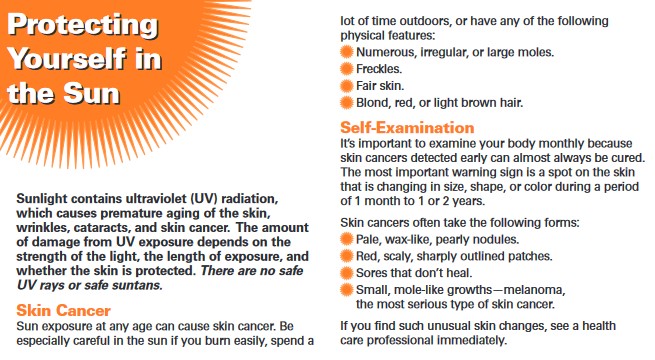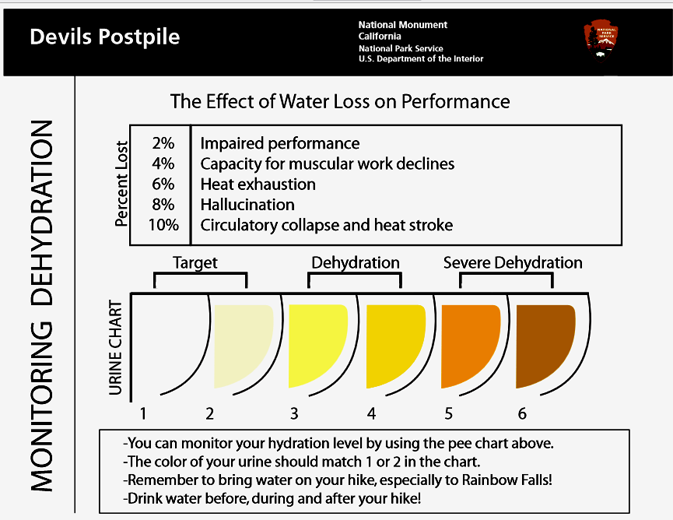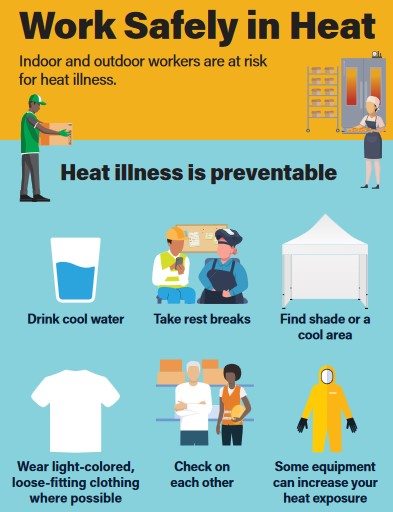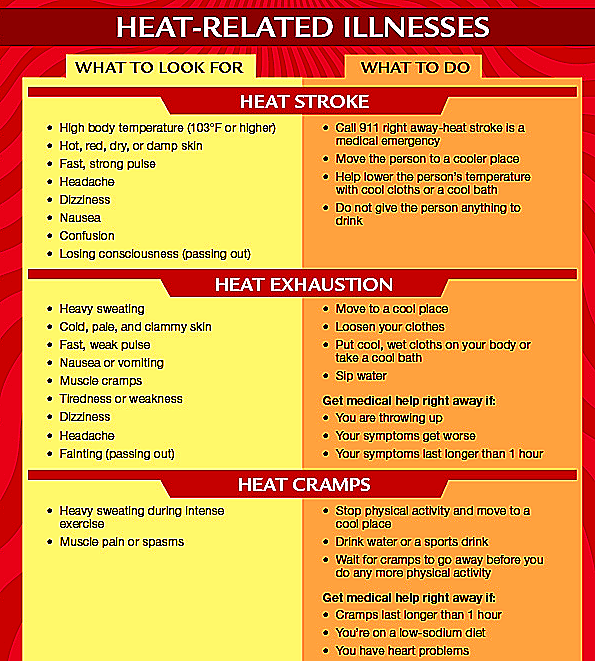In order from least to most severe, the heat-related illnesses are
heat cramps,
heat exhaustion
and heat stroke.
“Sunstroke” and “sun poisoning” are not the correct words / terms / phrases for professional rescuers such as lifeguards, EMTs, nurses, and other emergency room personnel, or even just people who do first aid, to use for heat stroke, heat exhaustion or even sunburn.
——————————————————————-
Many National Park Service (NPS) webpages say:
“When spending the day in the sun it is important to protect yourself from sunburn, dehydration, heat exhaustion, and heat stroke.
Sunburn
Prevention:
• Wear high protection sunscreen on all exposed skin and reapply every 3 hours.
• Stay hydrated and keep your body cool.”
The American Cancer Society has skin cancer prevention info at:
https://www.cancer.org/cancer/risk-prevention/sun-and-uv.html
including How to protect yourself from the sun:
OSHA offers this:

——————————————————————-
DEHYDRATION:
“Dehydration occurs when the amount of water leaving the body is greater than the amount coming in.
Symptoms:
• Thirsty
• Dry mouth
• Sweating may stop
• Muscle cramps
• Nausea and vomiting
• Lightheadedness
Prevention and treatment:
• Keep your body hydrated by drinking plenty of water.
• Keep rehydrating.
• It is important to hydrate before hitting the trail, as well as keeping hydrated throughout the day.”
The Red Cross says:
“The best prevention strategy for heat-related illnesses is to stay properly hydrated. Staying hydrated helps to make sure fluids lost through sweating are replaced, which helps to reduce the risk for experiencing a heat-related illness. Water is the best choice of fluid for staying hydrated. Drink a few ounces every 15 to 20 minutes or however much you need to not feel thirsty.”
Devil’s Postpile National Park put this chart up in restrooms for people to help them determine when they are dehydrated and need to drink more water:

• Drink enough to produce light yellow or almost clear urine throughout the day. Drink before, during and after exercise, working, hiking.”
Yosemite Search and Rescue Ranger John Dill wrote:
“No Yosemite climber has died from heat, but a half-dozen parties have come close. Too exhausted to move, they survived only because death by drying-up is a relatively slow process, allowing rescuers time to get there.
Temperatures on the sunny walls often exceed 100° Fahrenheit, but even in cool weather, climbing all day requires lots of water.
The generally accepted minimum, two quarts per person per day, is just that – a minimum. It may not replace what you use, so don’t let the desire for a light haul bag be your overriding concern, and take extra for unanticipated delays. Do not put all your water in a single container, and watch out for leaks.
If you find yourself rationing water, remember that dehydration will seriously sap your strength, slowing you even further. It’s not uncommon to go from mere thirst to a complete standstill in a single day. Continuing up might be the right choice but several climbers have said, “I should have gone down while I could.”
purifying drinking water while hiking, camping and backpacking
Why eat salty snacks?
When I volunteered with Preventative Search and Rescue (PSAR) in Yosemite, we told people:
Some people have needed to be rescued when they failed to include salty snacks in their diet, hiked a lot, got very hot and sweated a lot (sweating is your body’s number one way to to cool down), then could no longer sweat because they did not have enough salt to produce more sweat, and were unable to even walk, and were starting to die from the heat.
Lack of salty foods can be as dangerous as dehydration.
The National Park Service often warns hikers:
“Avoid becoming dehydrated or experiencing heat exhaustion. Drink plenty and drink often; pace yourself; rest in the shade; eat salty snacks.”
“Replace sodium lost through sweat by supplementing your water intake frequently with salty, easily digested snacks, such as trail mix or nuts.”
Avoid salt tablets, as they can irritate your stomach and cause nausea and/or vomiting, can raise blood pressure, cause stomach ulcers, and seriously affect people with heart disease.
–but a few salty snacks are a good idea to replenish salt after sweating. GORP and hiking snacks has ideas well beyond salted peanuts.
The CDC says:
“Replace salts and minerals.
Heavy sweating removes salt and minerals from the body that need to be replaced. A sports drink can replace the salt and minerals you lose in sweat.
If you are on a low-salt diet, have diabetes, high blood pressure, or other chronic conditions, talk with your doctor before drinking a sports beverage or taking salt tablets.”
——————————————————————-

More from National Park Service webpages:
“Heat exhaustion
Heat exhaustion occurs due to water and electrolyte loss due to sweating.
Symptoms:
• Heavy sweating
• Pale, clammy skin
• Nausea and vomiting
• Fatigue
• Weakness, dizziness, and fainting
• Headache
• Muscle cramps and aches
• Rapid pulse
• Pale skin
• Low blood pressure
Prevention:
• Avoid becoming dehydrated and avoid vigorous physical activities in hot and humid weather.
• Keep rehydrating your body.
• Wear light colored, lightweight, and loose clothing.
• Avoid alcohol and caffeine when exercising in the heat”

(The CDC (Centers for Disease Control and Prevention) warns: “Pace Yourself: Cut down on exercise during the heat. If you’re not accustomed to working or exercising in a hot environment, start slowly and pick up the pace gradually. If exertion in the heat makes your heart pound and leaves you gasping for breath, STOP all activity. Get into a cool area or into the shade, and rest, especially if you become lightheaded, confused, weak, or faint.)”

“Treatment:
• Cool victim down and have them rest in the shade
• Drink plenty of water or electrolyte drink
• Monitor victim’s temperature
• If vomiting occurs, seek immediate medical assistance
Signs and symptoms of heat exhaustion may develop suddenly or over time, especially with prolonged periods of exercise.
Possible heat exhaustion signs and symptoms include:
• Cool, moist skin with goose bumps when in the heat
• Heavy sweating
• Faintness
• Dizziness
• Fatigue
• Weak, rapid pulse
• Low blood pressure upon standing
• Muscle cramps
• Nausea
• Headache
If you think you’re experiencing heat exhaustion:
• Stop all activity and rest
• Move to a cooler place
• Drink cool water or sports drinks
Contact your doctor if your signs or symptoms worsen or if they don’t improve within one hour. If you are with someone showing signs of heat exhaustion, seek immediate medical attention if he or she becomes confused or agitated, loses consciousness, or is unable to drink. You will need immediate cooling and urgent medical attention if your core body temperature (measured by a rectal thermometer) reaches 104 F (40 C) or higher.”
The Mayo Clinic notes:
“Causes of heat exhaustion include exposure to high temperatures, particularly when combined with high humidity, and strenuous physical activity.
Without prompt treatment, heat exhaustion can lead to heatstroke, a life-threatening condition.
Fortunately, heat exhaustion is preventable.”
——————————————————————-
Heat Stroke
Heat stroke is a true medical emergency that can be fatal if not properly and promptly treated.
It occurs when undertaking heavy exertion in hot weather.
OSHA notes: “Nearly 3 out of 4 heat illness fatalities happen during the first week of work.
New and returning workers need to build tolerance to heat by taking frequent breaks
and working shorter shifts in the heat to start.”

“Symptoms:
• Headache
• Drowsiness
• High body temperature
• Rapid pulse
• Not sweating with hot red or flushed dry skin
• Difficulty breathing
• Strange behavior; decreased mental status, confusion, or disorientation
• Irritability
• Shock
• Convulsions or seizure
• Sudden collapse
Prevention:
• Avoid becoming dehydrated and avoid vigorous physical activities in hot and humid weather.
• Keep rehydrating your body.
• Wear light colored, lightweight, and loose clothing.
• Avoid alcohol and caffeine when exercising in the heat
Treatment:
• Contact emergency services
• Move victim to a shady place and cool down by bathing or sponging with cool water
• Apply cool water and place icepacks on the neck, abdomen, armpits, and groin
• Monitor victim’s temperature”
The CDC (Centers for Disease Control and Prevention) notes: “Heat stroke is the most serious heat-related illness. It occurs when the body can no longer control its temperature: the body’s temperature rises rapidly, the sweating mechanism fails, and the body is unable to cool down. When heat stroke occurs, the body temperature can rise to 106°F or higher within 10 to 15 minutes. Heat stroke can cause permanent disability or death if the person does not receive emergency treatment.
Fanning a heat stroke victim is not effective enough.”
The Red Cross says:
“If a person is experiencing signs and symptoms of a heat-related illness, you should offer the person small amounts of a cool drink containing carbohydrates and electrolytes (such as a commercial sports drink, coconut water, or milk), or water if one of these options is not available.
Only give the person fluids if the person is responsive and able to swallow, and encourage the person to take small sips rather than gulping the drink down quickly.
Heat Exhaustion can rapidly become Heat Stroke. Heat stroke is life threatening.
A person who is showing signs and symptoms of heat stroke needs immediate cooling and medical attention because heat stroke can be fatal.
Being outdoors is a risk factor for developing a heat-related illness, but these illnesses can also affect people who are indoors. People who live or work in buildings that are inadequately cooled or ventilated are at risk, as are those who perform indoor jobs in hot, humid environments (e.g., kitchen and laundry workers, factory workers).”

The CDC(Centers for Disease Control and Prevention) has this advice about exercising in heat:
https://www.cdc.gov/extreme-heat/risk-factors/extreme-heat-and-athletes.html
https://www.cdc.gov/extreme-heat/prevention/
![]()
From NPS (National Park Service)
https://www.nps.gov/yose/blogs/a-wave-of-heat-related-incidents.htm
” . . . within a 24-hour span, Yosemite National Park emergency medical providers responded to three medical calls related to dehydration and heat exhaustion.
In all three cases, the subjects had been hiking in the heat of the day. None had been drinking adequate amounts of water while hiking. The three subjects reported various telltale signs and symptoms of dehydration and heat exhaustion: they felt dehydrated, fatigued and exhausted, hot and even feverish, and experienced nausea and vomiting. The subjects went hours and hours without urinating and when they did urinate, the urine was dark yellow.
These incidents all provide a good opportunity to review tips for staying strong and healthy while hiking in the summer heat:
Hike with—and drink—plenty of water. Eat salty snacks, or drink electrolyte beverages, to maintain a proper balance of electrolytes.
Keep drinking water even after your adventure is over.
• Pay attention to your output—if you go hours without visiting a restroom (or the woods!), your body needs more fluids.
• Rest frequently in the shade, especially during the heat of the day. Consider soaking a bandana or buff with water and putting it around your neck to help cool your body.
• Consider wearing sun-protective clothing and a hat to avoid sunburn and keep you cool.
• Avoid stimulants and alcohol before, during, and immediately after a strenuous hike or other outdoor activity.”
——————————————————————-
The CDC (Centers for Disease Control and Prevention) warns:
“Do Not Leave Children in Cars: Cars can quickly heat up to dangerous temperatures, even with a window cracked open. While anyone left in a parked car is at risk, children are especially at risk of getting heat stroke or dying. When traveling with children, remember to do the following:
• Never leave infants, children or pets in a parked car, even if the windows are cracked open.
• To remind yourself that a child is in the car, keep a stuffed animal in the car seat. When the child is buckled in, place the stuffed animal in the front with the driver.
• When leaving your car, check to be sure everyone is out of the car. Do not overlook any children who have fallen asleep in the car.
and the National Highway Traffic Safety Administration tells us:
“A child’s body temperature rises three to five times faster than an adult’s. When a child is left in a vehicle, that child’s temperature can rise quickly — and the situation can quickly become dangerous.
Heatstroke begins when the core body temperature reaches about 104 degrees. Death occurs at a core body temperature of 107 or above.
In 2024, 39 children died of heatstroke in vehicles — up 35% from 2023.
If you see a child alone in a locked car, act immediately and call 911. A child in distress due to heat should be removed from the vehicle as quickly as possible and rapidly cooled.”
– – – – – – – – – – – – – – – – – – – – – – – – – – – – – – – – – – –
The CDC also warns: “Some medications interfere with thermoregulation and/or fluid balance, amplifying the risk of harm from hot weather (e.g., diuretics, some antipsychotic medications, some antidepressants, some antihypertensive agents).”
– – – – – – – – – – – – – – – – – – – – – – – – – – – – – – – – – – –
(Note to on-line users not in my classes: this is a study sheet. It is not complete instruction in first aid or the topic named in the webpage title.)
The author of this webpage, (written as a homework reading assignment for my students), does not give any warranty, expressed or implied, nor assume any legal liability or responsibility for the accuracy, completeness, or usefulness of any information, product, or process included in this website or at websites linked to or from it. Users of information from this website assume all liability arising from such use.
– – – – – – – – – – – – – – – – – – – – – – – – – – – – – – – – – – –